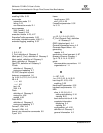
SN0054614-00 F Glossary-5
SANsurfer FC HBA CLI User’s Guide
Command Line Interface for QLogic Fibre Channel Host Bus Adapters
A
N_Port ID Virtualization
The ability for a single physical FC end
point (N_Port) to support multiple, uniquely
addressable, logical end points. With
NPIV, a host FC adapter is shared in such
a way that each virtual adapter is assigned
to a virtual server and is separately identifi-
able within the fabric. Connectivity and
access privileges within the fabric are
controlled by identification of each virtual
adapter and, hence, the virtual server
using each virtual adapter.
NL_Port (Node Loop Port)
A port capable of arbitrated loop functions
and protocols. An NL_Port connects
through an arbitrated loop to other
NL_Port and at most a single FL_Port.
NL_Ports handle creation, detection, and
flow of message units to and from the
connected systems. NL_Ports are end
ports in virtual point-to-point links through
a fabric, for example NL_Port to F_Port to
F_Port to N_Port using a single FC fabric
switch. In the absence of a fabric switch
FL_Port, NL_Ports can communicate with
other NL_Ports in virtual point-to-point
links through a FC_AL open loop circuit
often through FC_AL (Arbitrated Loop)
hub or loop switch devices. See: E_Port
(Expansion Port), F_Port, FL_Port (Fabric
Loop Port), G_Port (Generic Port), N_Port
(Node Port).
NIC
Network Interface Controller.
NVRAM (Non-Volatile Random Access
Memory)
A type of memory that retains data even
when power is removed. Holds configura-
tion settings. You can configure NVRAM
settings manually or restore them from a
file. These settings are retained when
power is removed. NVRAM settings are
called HBA Parameters in this guide.
network adapter
A chip that provides network capabilities. A
computer may include a network adapter
on its system board, or on an adapter card.
Also a NIC (network interface card or
controller).
ONC (Open Network Computing)
A remote procedure call developed by Sun
Microsystems.
path
A path to a device is a combination of a
HBA port instance and a target port as
distinct from internal paths in the fabric
network. A fabric network appears to the
operating system as an opaque network
between the HBA (initiator) and the target.
Since a path is a combination of an HBA
and a target port, it is distinct from another
path if it is accessed through a different
HBA and/or it is accessing a different
target port. Consequently, when switching
from one path to another, the driver might
be selecting a different HBA (initiator), a
different target port, or both.
This is important to the driver when
selecting the proper method of failover
notification. It can make a difference to the
target device, which might have to take
different actions when receiving retries of
the request from another initiator or on a
different port.
point-to-point
Also FC-P2P. Two FC nodes directly
connected (not in a loop).
port
Access points in a device where a link
attaches. There are four types of ports, as
follows:


















